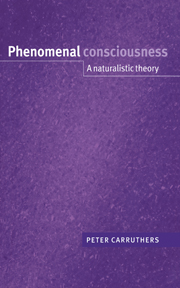Book contents
- Frontmatter
- Contents
- List of figures
- Preface
- 1 Assumptions, distinctions, and a map
- 2 Perspectival, subjective, and worldly facts
- 3 Explanatory gaps and qualia
- 4 Naturalisation and narrow content
- 5 First-order representationalism
- 6 Against first-order representationalism
- 7 Higher-order representationalism: a first defence
- 8 Dispositionalist higher-order thought theory (1): function
- 9 Dispositionalist higher-order thought theory (2): feel
- 10 Phenomenal consciousness and language
- 11 Fragmentary consciousness and the Cartesian theatre
- Conclusion
- References
- Author index
- Subject index
1 - Assumptions, distinctions, and a map
Published online by Cambridge University Press: 30 September 2009
- Frontmatter
- Contents
- List of figures
- Preface
- 1 Assumptions, distinctions, and a map
- 2 Perspectival, subjective, and worldly facts
- 3 Explanatory gaps and qualia
- 4 Naturalisation and narrow content
- 5 First-order representationalism
- 6 Against first-order representationalism
- 7 Higher-order representationalism: a first defence
- 8 Dispositionalist higher-order thought theory (1): function
- 9 Dispositionalist higher-order thought theory (2): feel
- 10 Phenomenal consciousness and language
- 11 Fragmentary consciousness and the Cartesian theatre
- Conclusion
- References
- Author index
- Subject index
Summary
The nature and aims of my project have already been explained in the Preface. In this opening chapter I shall lay out some of my background assumptions, introduce a number of important distinctions, and outline the direction which the discussions of later chapters will follow.
Physicalism and naturalism
In this section I shall briefly explain and defend two default assumptions, which form the background to the problem of phenomenal consciousness. It is these assumptions which appear to be challenged by the very existence of phenomenal consciousness, as we shall see in chapters 2 and 3.
Physicalism
One assumption I shall make is that we should at least try to be token-physicalists about the mind. We should maintain that all particular (or ‘token’) mental states and events are at the same time physical (presumably neurophysiological) states and events, if we can do so consistently with our other beliefs. In the present section I shall briefly motivate this assumption, which is shared by almost everyone now working in the philosophy of mind – which is not to say that physicalism itself is mandatory, of course; indeed, many of the arguments against physicalism derive from considerations to do with phenomenal consciousness, as we shall see.
- Type
- Chapter
- Information
- Phenomenal ConsciousnessA Naturalistic Theory, pp. 1 - 26Publisher: Cambridge University PressPrint publication year: 2000



